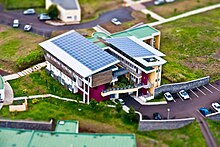ENERPOS
| ENERPOS | |
|---|---|
| Informations | |
| Type | Educational building |
| Owner | University of Reunion Island |
| City | Saint-Pierre |
| Country | France |
| Opening | 2008 |
| Specifications | |
| Net floor area | 739 m² |
| Energy consumption | 9,824 kWh |
| Air conditioning space | 246 m² |
| Percentage of air conditioning space | 36 % |
| Cost |
$1.7 million 3,200 €/m²NFA – 1,660 €/m²GFA |
| Others | |
$1.7 million
ENERPOS (which stands for Positive Energy in French) is the first educational net-zero energy building in the tropics and one of the 13 Net ZEBs in the tropics thanks to its bioclimatic design. ENERPOS is located on Reunion Island, a French territory in the Indian Ocean. Building an energy efficient building in such a climate is particularly challenging. However, the energy expectations with regard to ENERPOS have been reached, even largely exceeded.
ENERPOS is not only an energy-efficient building, but also displays various passive methods to reduce energy consumption while providing a comfortable environment for its users. Classes are hosted for both undergraduate diploma and degree courses as well as for the Department of Construction and Energy at the Graduate Engineering School of Reunion Island.
ENERPOS is a university building located in Saint Pierre on the French island of La Reunion. This island, whose climate is hot and humid, is located in the Indian Ocean, to the east of Madagascar. This area is also often struck by tropical cyclones, generating building difficulties.
Over 800,000 inhabitants of Reunion Island rely on a limited supply of energy. In addition to that, electricity production on Reunion Island is one of the most polluting on earth, mainly generated from fossil fuels such as coal and fuel. The electricity produced is expensive and is one of the most polluting in the world with 820 gCO2/kWhel (close to eight times more than in mainland France). Unfortunately, the ever-increasing demand for energy, due to a significant demographic growth, sometimes exceeds the amount of energy available. As a consequence, shortages can occur certain times during austral summers when air conditioning is widely used.
As is the case in other parts of the world, the electricity consumption of buildings represents a significant percentage of the energy used on Reunion Island. Buildings in French Tropical zones, and especially on Reunion Island, have often been awkwardly designed, contrary to former Creole vernacular architecture, importing metropolitan building concepts. Indeed, it has been common practice to build as cheaply as possible for decades, without any consideration for the environment and the climate, making it uncomfortable to live in without air conditioning. Moreover, air conditioning and lighting are usually oversized by designers, this leads to wasteful energy consumption. The good news is that considerable improvements can be made in reducing energy consumption in the field of building in Reunion island.
In accordance with the general context of energy supply and consumption on Reunion Island, this building was expected to be net zero energy and to export at least as much energy as its consumption to the polluting electricity grid of the island. To achieve this goal, the first issue to be addressed is the energy consumption of the building and how to build without using air conditioning, a considerable consumer, while providing a comfortable environment for the users. Air conditioning is only used in one third of the total surface area for computers and servers, the remaining two-thirds are cooled and ventilated naturally. Passive methods are used, requiring people to be active instead of being passive in an active building (François Garde, Ph.D., P.E. and ASHRAE member). At the beginning of the design of ENERPOS in 2005, the main aim was to demonstrate that the overall consumption of the building could be reduced by three times compared to that of a standard building. The result is that only one-seventh of the annual energy consumption of a standard building is used (14kWh/m² instead of 100kWh/m² in a year). To compensate for this, photovoltaic panels are implemented over the rooftops, enabling a production of 71,118kWh in 2010 compared to an overall consumption of 9,824kWh, making this building one of the 13 Net ZEBs in a tropical climate. The city of Saint Pierre is usually sunny all year and receives a heavy amount of solar radiation with up to 1,200W/m² in summer. Consequently, the building consumes 7 times less energy than its production, the extra production of electricity being released into the grid.
...
Wikipedia

